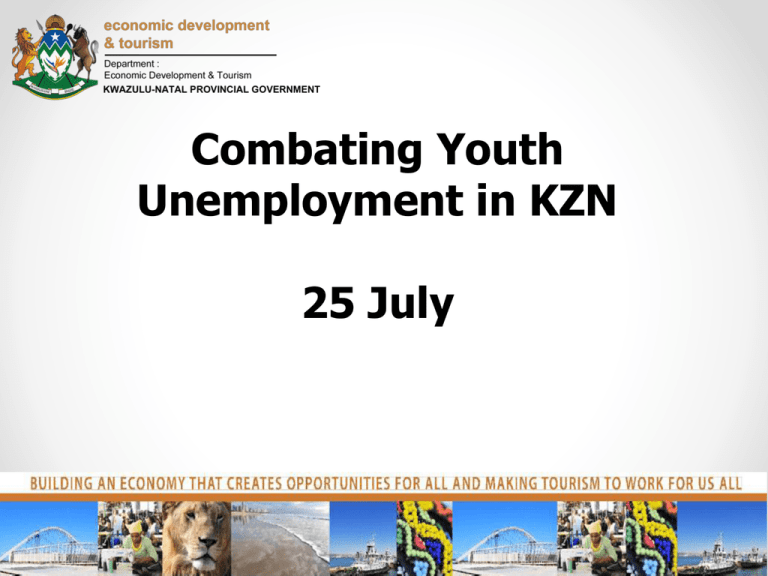Provincial Spatial Economic Development Strategy (PSEDS
advertisement

Combating Youth Unemployment in KZN 25 July Contents 1. Introduction 2. The scale of the problem of youth unemployment 3. Diagnosing youth unemployment 4. Strategic interventions 5. Conclusion 2 Introduction • The hopes of creating a more prosperous, more inclusive society and economy rest on the shoulders of the country’s youth. Youth unemployment, however, tends to perpetuate a cycle of social and economic exclusion which often leads to the germination of civil unrest and criminal activity. • As such, combating youth unemployment with the use of policy tools and through strategic interventions, is a major focus of government. • This presentation is a reflection of the work the Department of Economic Development and Tourism is currently undertaking on the revision of the Youth Economic Empowerment Strategy. 3 The Scale of the Problem of Youth Unemployment 4 Youth Unemployment in SA • The principal determinant of poverty within South Africa is undoubtedly unemployment or put differently, a lack of employment. • Only 41% of the country’s working age population are employed. Such a low employment rate severely hampers the ability of individuals to access economic resources. • The official rate of unemployment in the country is 25% while the expanded rate is 36% • The Youth (aged 15-34) constitute a disproportionate share of the unemployed – 72% of the total unemployed. • The rate of unemployment for working age people below the age of 25 is as high as 49% on the strict definition of unemployment. 5 Youth Unemployment in SA • A recent study conducted by the ILO found South Africa to have the lowest youth labour absorption (employment rate) of any country with recorded statistics. Only 12.5% of working-age South Africans younger than 25 were employed, compared to 40% for most developing country youth. • Labour force participation is similarly low at 24.4%, indicating that not only are youth struggling to find work, but a large portion do not even actively seek work. • South Africa is a regional outlier with a much higher rate of youth unemployment (around four times higher) than the Sub-Saharan average. • South Africa’s youth unemployment rates are only comparable with those of the North African Countries. 6 Youth Unemployment in SA In describing the impact of youth unemployment in North Africa, the ILO unwittingly serves a chilling warning to South Africa. “The collective frustration of a generation of youth that was granted the opportunity to gain an education but not given the same opportunity to gain decent employment was certainly a contributing factor behind mobilising youth in support of the political protest movements in Bahrain, Egypt, Libyan Arab Jamahiriya, Syrian Arab Republic and Tunisia. Consequently, promoting opportunities for decent employment for youth remains firmly fixed among the priority of the interim governments.” (ILO, 2011:5) 7 Youth Unemployment in KZN – Age distribution 75+ 70-74 Male Female 65-69 KwaZulu-Natal 60-64 South Africa 55-59 50-54 45-49 40-44 35-39 30-34 25-29 20-24 15-19 10-14 05-09 00-04 8.0% 6.0% 4.0% 2.0% 0.0% 2.0% 4.0% 6.0% Source: IHS Global Insight Regional eXplorer version 593 8.0% 8 Youth Unemployment in KZN • KwaZulu-Natal, as indicated in the figure has a younger population distribution than South Africa as a whole. • The provincial age distribution could be said to be bottom heavy, as KZN enjoys a greater share of the population in the first 6 age brackets than the country as a whole. • Based on the 15-34 years old definition of youth, 37.2% of KZN’s population can be considered to be ‘youth’ as compared to only 28% at a national level. • This relative ‘youth’ of KZN’s population implies that KZN is even more vulnerable to factors affecting the youth, than the country as a whole is. 9 Youth Unemployment in KZN Strict Unemployment Rate 70% 60% 50% 40% Unemployment rate KZN Unemployment rate SA 30% 20% 10% 0% 04: Age 15-19 05: Age 20-24 06: Age 25-29 07: Age 30-34 08: Age 35-39 09: Age 40-44 10: Age 45-49 11: Age 50-54 12: Age 55-59 13: Age 60-64 14: Age 65+ 10 Youth Unemployment KZN • KwaZulu-Natal has a lower strict youth unemployment rate than the country as a whole, but this is based on the strict definition, the expanded definition presents a different picture Region Strict Rate of Unemployment Broad Rate of Unemployment 15-24 15-34 15-24 15-34 KZN 42.1% 28.9% 66.8% 48.4% SA 49.2% 34.0% 64.5% 47.4% • A higher expanded youth unemployment rate for the province suggests a relatively high level of discouragement among young work-seekers 11 Discouraged Work-seeking in KZN 15-24 15-34 KZN 23.3% 17.2% South Africa 20.1% 14.6% • High levels of discouragement among the youth point to challenges relating to the cost of job search and to the negative impact of young people having minimal previous work experience. • Youth economic empowerment strategies must be targeted not simply at the searching unemployed youth but also at the discouraged wok-seekers as this group makes up a large portion of the broad youth labour force in the province. 12 Youth Employment 13 Youth Employment • Wholesale and Retail Trade sector is the sector in which the most youth (29%) are employed in the province. • Interestingly this sector accounts for only 24% of total employment in the province. The Wholesale and Retail Trade sector can thus be regarded as a relatively youth intensive sector. • Conversely the youth are not particularly well represented in the Community, Social and Personal Services sector (15%) when compared to the total employment representation in this sector (20%). • This may in part be due to this sector requiring tertiary qualifications (especially for teachers; and medical professionals), which the youth are yet to attain. 14 Diagnosing the Problem 15 Structural factors • The national planning commission identifies two main causes for high youth unemployment – Labour market rigidities negatively biasing against the employment of youth – Poor skills acquisition and sub-standard educational outcomes Low labour productivity and high risk vis-à-vis high wages 16 An un-conducive labour market • “Relatively high starting salaries in some sectors and the disincentive to hire inexperienced workers are at least part of the explanation for high youth unemployment”. (National Planning Commission, 2011:13) • Young people have often never worked before and hence don’t have the requisite experience which acts as a positive signal to employers of their productivity. • They are, therefore, assumed to be less productive and a more risky employment prospect than a 36 year old which has already had a few jobs. • Employers would be willing to take a risk in hiring younger workers if the cost of doing so were lower than it is for hiring more experienced workers. • This however is not the case and the youth come to be considered as high cost, high risk employees 17 Skills gap • The Diagnostic Overview points to a disjuncture between the needs of a modernising economy and the skills acquired by young people at learning institutions. • Employers’ requirements have increased as the economy has developed and matured, and a Matric qualification has changed from being a key differentiator or a high-end signal of superior productivity to now being a minimum qualification requirement. • However only 44% of the working age population have a matric qualification. • The National Planning Commission believe that; “lack of job readiness is a strong disincentive to hiring young people, and when people cannot get stable employment before they reach the age of 24, the chance of them ever getting a permanent, stable job falls dramatically”. 18 Youth Labour High Risk and High Cost • The National Planning Commission conclude that “the inability to support young people to make the school-to-work transition is probably the biggest challenge of the labour market” (National Planning Commission, 2011:13). • It is in this regard that the issue of youth unemployment comes full circle – poor educational outcomes and a low level of skills among the youth necessitates that employers undertake risks and endure additional costs in hiring young people, but rigid labour legislation acts as a disincentive for employers to take such risks and blocks their ability to counter such costs. 19 Dynamic Factors – Global Recession • The unemployment rate for 15-24 year olds dropped from 55.9% to 46.6% during the 2002-2008 period. • However the global recession in 2009 took a heavy toll on the Youth and in 2010 the unemployment rate for this age group was back up to 51.3%. • In fact, the National Planning Commission attributes almost all the job losses in 2009/2010 to those aged younger than 30. National Treasury reports that employment of 15-24 year olds has declined by 22% since 2008. • This trend is not unique to SA - the ILO find that Youth are most vulnerable in times of recession because they tend to be the “first out and last in”. • Indeed, global youth unemployment rose by almost 1% in 2010, and has since been very sticky in returning to post-recession levels. 20 Implications for Youth Development • South Africa/KwaZulu-Natal has a long history of severe youth unemployment. • This is in no small part due to the skewed legacy of development which saw restrictions on labour mobility and poor educational outcomes for the youth. • Significant inroads into reducing youth unemployment were made in the 2002-2008 period, aided by strong economic growth rates. • The global recession, however, has been a major setback for youth employment and its impact has remained pervasive. • In a new context of relatively subdued growth prospects, Government; the Private sector and civil society need to think of innovative ways to improve labour market outcomes for the youth. 21 The KZN Youth Economic Empowerment Strategy Initial (Draft) Work: 22 GOAL 2: To Enhance Employment opportunities for the Youth To provide youth with work experience opportunities To facilitate easier entry for the youth into the labour market Develop sector specific employment opportunities for youth 23 Strategic Objective 1: Work Experience It is important to provide the youth with opportunities to gain work experience. By providing the youth with these opportunities, the cycle of insufficient experience causing unemployment and unemployment causing insufficient experience can be broken. 1. 2. 3. 4. Implement school holiday work experience programmes with the private sector Introduce a Youth Corps Initiative – ‘Green Army’ Provide incentives for business to extend more franchise opportunities to youth Establish mentorship programmes for young businessmen 24 Strategic Objective 2: Easier labour market entry It is the role of both national and provincial government to make the transition of the youth from studying to working as seamless and easy as possible. In this regard government should look to remove the constraints and impediments to labour market entry for the youth. 1. 2. 3. Support the review of labour legislation to ensure that ‘insiders’ are not favoured to the extent of shutting youth out of the labour market Assess the impact of the introduction of a Youth Wage Subsidy Establish dedicated job search centres for youth which aim to ensure that job search costs are not prohibitive to youth finding work 25 Strategic Objective 2 cont.. 4. 5. 6. 7. Undertake an audit of companies skills needs and facilitate the matching of the supply and demand of skills Facilitate job readiness and interview training Entrepreneurship Training Provide assistances in the formulation of bankable business plans 26 Strategic Objective 3: Develop sector opportunities This strategy objective focuses on sectors in which the youth can claim to have a comparative advantage, and aims to develop these sectors in such a way as to fully exploit the potential for youth employment creation in them. 1. 2. 3. 4. Exploit low-hanging fruit of ICT sector including the roll-out of broadband. And support dot.com entrepreneurs Develop opportunities for youth in the green economy Provide support for youth entrepreneurship in the tourism sector Facilitate the re-involvement of youth in the agricultural sector 27 Thank You 28











